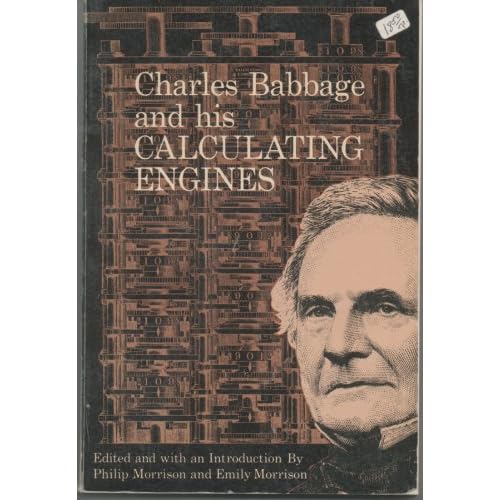Philip Morrison, Emily Morrison (eds.): Charles Babbage and his Calculating Engines (1961)
Filed under book | Tags: · computing, history of computing, history of technology, technology

Selected writings by Charles Babbage and others.
Publisher Dover Publications, 1961
Dover Histories and Classics of Science series
ISBN: 0486200124, 9780486200125
400 pages
PDF (DJVU; no OCR; updated on 2012-7-25)
Comment (1)Bruce Collier, James H. MacLachlan: Charles Babbage and the Engines of Perfection (1998)
Filed under book | Tags: · computing, history of computing, history of mathematics, history of technology, mathematics, technology

Charles Babbage, “the grandfather of the modern computer,” did not live to see even one of his calculating machines at work. A dazzling genius with vision extending far beyond the limitations of the Victorian age, Babbage successfully calculated a table of logarithms during his years at Cambridge University, allowing mathematical calculations to be executed with extreme precision. Only the possibility of human error prevented complete accuracy, and Babbage understood that the only way to attain perfection is to leave the human mind entirely out of the equation. He devoted most of his life and spent most of his private fortune and government stipend trying to improve his difference engines and analytical engines.
Bruce Collier and James MacLachlan chronicle Babbage’s education and scientific career, his remarkably active social life and long string of personal tragedies, his forays into philosophy and economics, his successes and failures, and the biggest disappointment of his life– his ingenious inventions were centuries ahead of the primitive capabilities of Victorian technology.
Publisher Oxford University Press, 1998
Oxford Portraits in Science series
ISBN 0195089979, 9780195089974
123 pages
PDF (updated on 2012-7-25)
Comment (1)Paul E. Ceruzzi: A History of Modern Computing, 2nd ed. (2003)
Filed under book | Tags: · computing, history of computing, history of technology, software, technology

This engaging history covers modern computing from the development of the first electronic digital computer through the dot-com crash. The author concentrates on five key moments of transition: the transformation of the computer in the late 1940s from a specialized scientific instrument to a commercial product; the emergence of small systems in the late 1960s; the beginning of personal computing in the 1970s; the spread of networking after 1985; and, in a chapter written for this edition, the period 1995-2001. The new material focuses on the Microsoft antitrust suit, the rise and fall of the dot-coms, and the advent of open source software, particularly Linux.
Within the chronological narrative, the book traces several overlapping threads: the evolution of the computer’s internal design; the effect of economic trends and the Cold War; the long-term role of IBM as a player and as a target for upstart entrepreneurs; the growth of software from a hidden element to a major character in the story of computing; and the recurring issue of the place of information and computing in a democratic society. The focus is on the United States (though Europe and Japan enter the story at crucial points), on computing per se rather than on applications such as artificial intelligence, and on systems that were sold commercially and installed in quantities.
Edition 2
Publisher MIT Press, 2003
History of Computing series
ISBN 0262532034, 9780262532037
445 pages
PDF (updated on 2012-7-25)
Comment (1)
